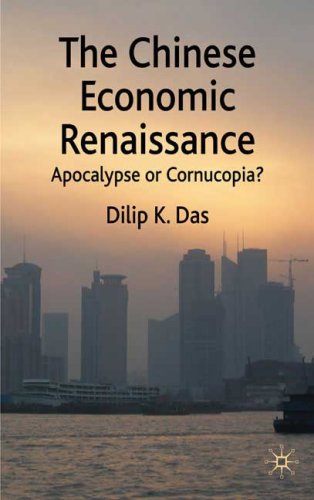

Most ebook files are in PDF format, so you can easily read them using various software such as Foxit Reader or directly on the Google Chrome browser.
Some ebook files are released by publishers in other formats such as .awz, .mobi, .epub, .fb2, etc. You may need to install specific software to read these formats on mobile/PC, such as Calibre.
Please read the tutorial at this link: https://ebookbell.com/faq
We offer FREE conversion to the popular formats you request; however, this may take some time. Therefore, right after payment, please email us, and we will try to provide the service as quickly as possible.
For some exceptional file formats or broken links (if any), please refrain from opening any disputes. Instead, email us first, and we will try to assist within a maximum of 6 hours.
EbookBell Team

0.0
0 reviews
ISBN 10: 0230218407
ISBN 13: 9780230218406
Author: D Das
Following the launch in China of economic reforms and the 'open door policy', a new era of economic growth and global integration dawned. In 2008, the thirtieth anniversary year, China completes three decades of broad-based market-oriented macroeconomic reforms and restructuring. This book traces China's economic renaissance.
1 A Chinese Renaissance: Three Decades of Inexorable Economic Progress
1.1 Making an economic U-turn
1.1.1 A unique development model
1.1.2 Why the reform and liberalization program succeeded
1.1.3 Two vital variables: Saving and investment
1.1.4 Demographic bonus
1.1.5 Total factor productivity (TFP) growth
1.1.6 Rapid growth and relentless economic ascent
1.1.7 Downside of relentless economic ascent
1.2 Comparison with the other Asian high achievers
1.2.1 Larger potential global impact of China
1.2.2 China's global acceptance
1.3 Evolution of a large trading economy
1.3.1 WTO accession: Marathon negotiations
1.3.2 Emergence of an export juggernaut
1.3.3 Outer-orientation and economic transformation
1.4 A magnet for FDI
1.4.1 The quantitative dimension and geographical concentration of FDI
1.4.2 Did China eat ASEAN's lunch?
1.4.3 Did FDI stimulate growth?
1.4.4 Dawn of a dual economy
1.5 Multinational corporations (MNCs) in China
1.5.1 Stumbling blocks faced by the multinationals
1.5.2 Multinationals and Chinese trade
1.5.3 Multinationals and intensification of R&D
1.5.4 Changing conditions for success
1.6 Managing the foreign exchange reserves
1.6.1 Merits and demerits of large reserve holdings
1.6.2 Credible alternative usages of the reserves
1.6.3 Launch of a sovereign wealth fund (SWF)
1.7 Growth pangs and administrative failures
1.8 Cost of rapid growth: Environmental degradation
1.9 Future prospects and the growth trajectory
1.9.1 Medium- and short-term growth prospects
1.9.2 Longstanding limitations
1.9.3 Rebalancing the economy: Transitioning to a new growth path
1.9.4 China's place in the global economy
1.10 Summary and conclusions
2 A Chinese Renaissance in an Unremittingly Integrating Regional Economy
2.1 Introduction
2.2 China and the Asian economies: Two plausible scenarios
2.2.1 Upgrading the technology base
2.2.2 Expansion of intraregional trade and vertical specialization
2.2.3 Functioning of regional production networks
2.2.4 Effects of vertical specialization on China's trade configuration
2.2.5 China's competitive threat in various technology categories
2.2.6 Has China turned into an outlier?
2.3 China's trade expansion and the Asian economies
2.3.1 Explanation of the co-movement in trade
2.3.2 Country- and sector-specific differences
2.4 FDI inflows into China and the Asian economies
2.4.1 China's ability to entice regional and global FDI
2.4.2 Did China receive excessive FDI?
2.4.3 China and the Asian economies: A zero-sum-game assumption
2.5 A strategy for coping with China's economic expansion
2.6 China's regional integration posture and recent initiatives
2.7 Summary and conclusions
3 A Chinese Renaissance in an Unremittingly Integrating Global Economy
3.1 China and the global economy: A fundamental repositioning
3.1.1 An unprejudiced assessment
3.1.2 Ascendance as a soft-power of global magnitude
3.1.3 The geostrategic stance of peaceful ascendancy
3.1.4 Modest role in the global economic fora
3.2 China as a source of global growth
3.3 Channels of impact over the global economy
3.4 WTO accession and its consequences
3.4.1 Expanding international competitiveness and the global impact
3.5 Outward FDI and the "Going Global" strategy
3.6 Modeling China's global integration
3.7 How to dance with China: Formulating a functional strategy
3.8 Summary and conclusions
4 The Chinese Renaissance and the Transpacific Macroeconomic Imbalances
4.1 Macroeconomic imbalances in the global economy
4.2 Persistence and magnitude of the Chinese current account surplus
4.3 Persistence and magnitude of the US current account deficit
4.4 China's bilateral trade surplus vis-à-vis the US
4.4.1 The bilateral trade structure
4.4.2 Product drivers of bilateral trade
4.4.3 Bilateral trade and China's incentive zones
4.4.4 Exports to the US by the FIEs
4.4.5 The probability of contraction of Chinese exports to the US
4.5 Transpacific financial imbalances: Stable or unstable
4.6 Diverse perspectives on transpacific macroeconomic imbalances
4.7 Winding down the payments imbalances between China and the US
4.7.1 Multilateral consultations on transpacific imbalances
4.7.2 An accord to unwind the transpacific imbalances
4.8 Summary and conclusions
5 The Chinese Renaissance and Its Currency Conundrum
5.1 Evolution of China's exchange rate regime
5.2 Misalignment of the RMB yuan
5.2.1 Undervaluation and Balassa-Samuelson hypothesis
5.2.2 Undervaluation and the BEER, the PEER and the FEER estimates
5.3 Revaluation of the RMB yuan
5.3.1 Why the revaluation expectations were rife
5.3.2 Why market expectations were belied
5.3.3 Pressure for appreciation on the RMB yuan
5.3.4 The opportunity cost of undervaluation
5.3.5 Finally the miniature revaluation
5.3.6 Life after the reform of the exchange rate regime
5.4 An unambiguous dichotomy of perspectives
5.5 Trade response to currency value movement
5.5.1 Consequences for China's trade
5.5.2 Consequences for the Asian economies
5.5.3 Consequences for the China-US bilateral trade
5.5.4 Generalized currency appreciation with the other Asian economies
5.6 The subprime mortgage crisis and the RMB yuan appreciation
5.7 Summary and conclusions
Notes
the chinese renaissance
3 effects of the renaissance
renaissance era in china
explain the economic rebirth that occurred during the renaissance
economy of the xia dynasty
xia dynasty economics
Tags: D Das, Economic, Apocalypse